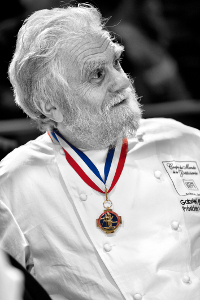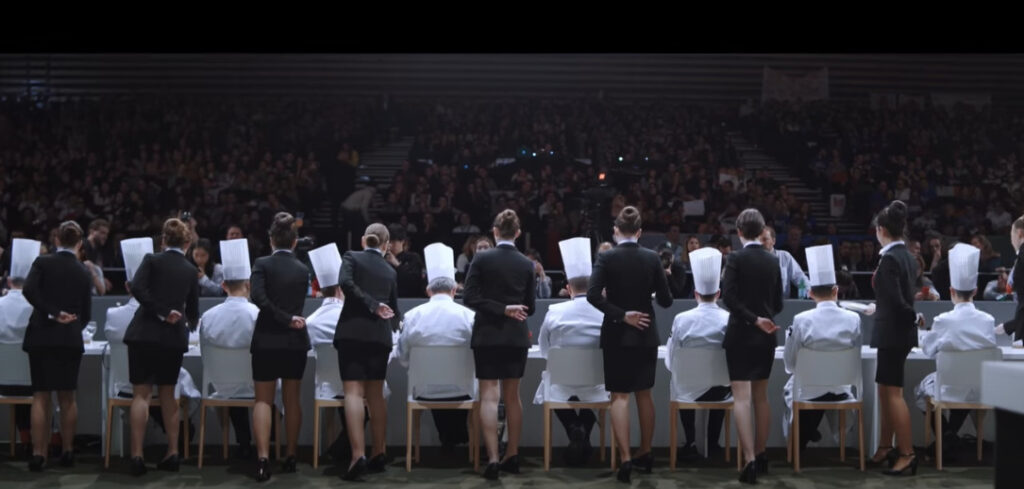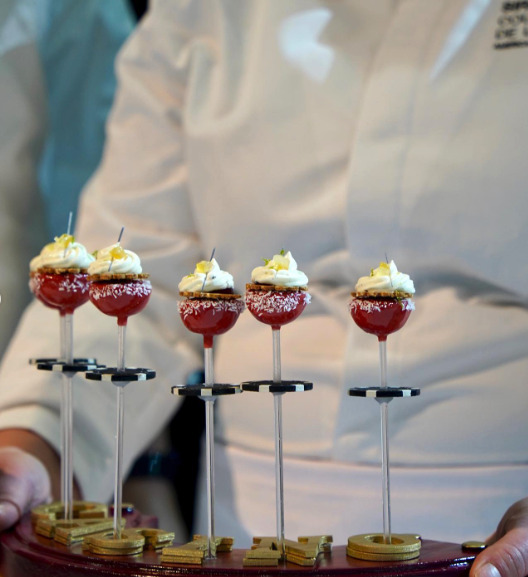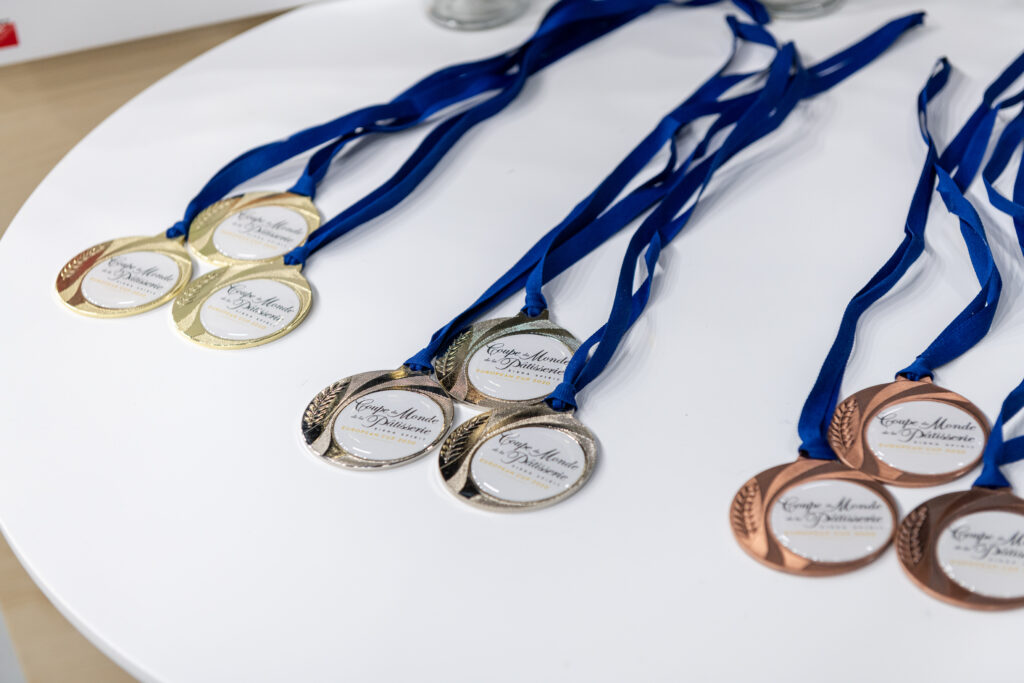In this eight-part series, we are looking at all the components that make up the Coupe du Monde de la Pâtisserie competition. This biennial competition takes place during the odd years in Lyon, France.
Most Americans are not familiar with this major food event, let alone know that since 1989, when the competition started, a team of talented pastry chefs has represented the United States at this prestigious event.
In Part One, we detailed a brief history of the competition, what exactly is the Coupe du Monde de la Pâtisserie, and what is expected from the competitors – including this year. In part two, we will discuss the presidents & judges, the contest schedule, and scoring criteria.
Who Judges the Competition?
The Jury, or Judges, is made up of representatives from the participating countries who are taking part in the final. In order to preserve fairness and impartiality, the judges do not score any presentations from their respective countries.

Even though Chef Gabrielle Paillsson is the Honorary President of the organization, prior to the start of each Coupe du Monde de la Pâtisserie, an Honorary President is named for that year’s competition.
According to the Rules and Regulations, the Honorary President attends tastings but does not take part in the scoring. He/she is the “spokesperson for the judges.” In the event of a dispute, serious claim, or at the request of their own choosing, the Honorary President may meet with the President of the Coupe du Monde de la Pâtisserie, the Vice-Presidents, and members of the International Organizing Committee (I.O.C.). In addition, an Official Bailiff would also be in attendance to supervise the discussion and determine whether a final decision is made.

If a dispute arises among the Jury, they are required to report the issue to the Honorary President. In the event the President, Pierre Hermé and/or one of the Vice-Presidents are absent, the other Vice-President would have the authority to resolve the issue.
When it comes time to judge the restaurant dessert, a different set of chefs will judge that category. The Jury for the restaurant dessert will be made up of four restaurant pastry chefs and three chefs.
The Contest Schedule
As part of the Sirah Lyon restaurant trade show, the Coupe du Monde de la Pâtisserie will take place on 20 January & 21 January 2023. There will be 20 countries competing – 10 on the first day and 10 on the second day. The winners will be announced on the evening of 21 January.
The order in which teams compete and the timing will be randomly determined at least one month prior to the competition. This order also determines which contest laboratory or kitchen each team will occupy.
Each team has 10 hours, from start to finish, to present four tasting tests or dessert categories, three artistic tests or centerpieces, and the assembling of a buffet table incorporating all of the aforementioned.
On each day, the teams will begin at 6:00 a.m. and the competition runs until 4:00 p.m. After 90 minutes from the start, the presentation of the ice sculptures commences. The shared chocolate desserts come next, followed by the frozen dessert, frozen lollipops, the restaurant-style desserts and then the set up of the buffet with all the elements.
A gong will sound signaling to each team the time when they need to send out the dessert for the tasting. With the exception of the restaurant-style dessert, all others must be in their complete form. Points will be deducted for any item going out incomplete or finished after the gong.
The rules state that for a restaurant-style dessert, “a finishing touch to enhance the dessert (coulis, a scoop of ice cream, espuma [(a foam), sauce, etc] may be added after the gong and at the table in front of the Judges. Anything else other than the acceptable finishing touches will result in a penalty.
How the Contestants are Judged & Scored
Out of a total of 1,280 points, plus the possibility of an additional 200 bonus points for cleanliness and waste management, each team is scored in four categories: Work, Tasting, Artistic Pieces, and Buffet Presentation.
On the other hand, teams could also lose up to 1,300 points for failing to meet certain standards. Deductions could occur regarding recipes, not following the rules and regulations during the competition, failure to respect time limits, and failure to respect established weight requirements.

The Official Bailiff counts the points, calculates the Jury’s scores, and ranks the teams. In the event of a tie, the team with the highest tasting score will be declared the winner.
| CRITERIA | POINTS | COEF. | TOTAL SCORE |
| WORK Points awarded for hygiene, good organization and team harmony, skill, compliance with time requirements, and optimized use of raw materials | 20 | 8 | 160 |
| TASTING Whole Chocolate Cake and dessert to share Overall presentation, cutting – 5 points Creativity, respect for the theme – 7 points Balance of flavors – 8 points | 20 | 8 | 160 |
| Frozen Fruit Dessert Overall presentation, cutting – 5 points Creativity, respect for the theme – 7 points Balance of flavors – 8 points | 20 | 8 | 160 |
| Frozen Lollipops Overall presentation – 7 points Balance of flavors (texture & taste) – 8 points Originality of the shape – 5 points | 20 | 8 | 160 |
| Restaurant-style Dessert Presentation of the dessert – 7 points Balance of flavors – 8 points Compliance with requirements – 5 points | 20 | 8 | 160 |
| ARTISTIC PIECES Sugar Piece Clearness – 10 points Technique – 10 points Assembling & Artistic Elegance – 10 points | 30 | 4 | 120 |
| Valrhona block chocolate piece Clearness – 10 points Technique – 10 points Assembling & Artistic Elegance – 10 points | 30 | 4 | 120 |
| Water Ice Piece (ice carving) Clearness – 10 points Technique – 10 points Assembling & Artistic Elegance – 10 points | 30 | 4 | 120 |
| Buffet Presentation Points are awarded for the artistic arrangement, respect for the theme, and coherence of the mocks integrated into each artistic piece | 20 | 8 | 160 |
These are the maximum amount of points a team can achieve. The coefficient (COEF) number is the multiplier that determines the degree of importance in each category. Additionally, similar to gymnastics, figure skating, and other Olympic sports, a team can have points deducted from their score based on any errors they may make during the competition.
| PENALTIES | POINTS |
| RECIPES Failure to respect the deadline for sending the four recipes (desserts) tasting | -100 |
| RULES & REGULATIONS DURING THE TEST Failure to comply with the rules or established attempt to cheat; the I.O.C. reserves the right to remove the team in question | -100 |
| FAILURE TO RESPECT TIMING Whole chocolate cake/dessert to share Frozen fruit pureé dessert Frozen lollipops Restaurant-style dessert Buffet | -100 -100 -100 -100 -100 |
| FAILURE TO RESPECT WEIGHT REQUIREMENTS Whole chocolate cake/dessert to share Frozen fruit pureé dessert | -100 -100 |
A team can earn additional 100 bonus points to their score in two categories. One for Cleanliness -Laboratories (work kitchen) and appliances returned in their initial condition, as controlled by the Commissioners (I.O.C.) and the official bailiff’s record.
The other is for Waste Management. They could be awarded 100 points for the best approach and another 100 points for respect to products (no waste), bin bags will be weighed at the test of the competition, and the checking of how the waste was sorted.
There is a separate, special prize the Eco-Responsible award, given by the I.O.C. stewards to the team who has generated the least amount of waste and presented a reasoned CSR approach in their promotional video. The top three winning countries are excluded from this category.

The top three winning teams receive a cash prize, a trophy, and gold, silver, or bronze medals.
In part three, we will discuss the team’s laboratory (work kitchen) setup and breakdown, permitted products and equipment, and the whole chocolate cake/dessert to share category.